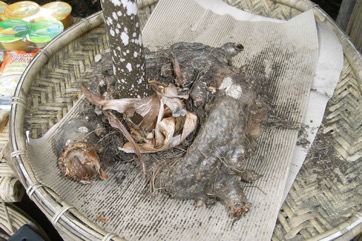Devil's tongue, Snake palm, Umbrella arum

A tropical plant. It is less tropical than Amorphophallus paenifolius var. campanulatus. It grows up to 3,000 m altitude in Vietnam. It suits hardiness zones 10-12. In Yunnan.
Also known as:
Bulei, Jia mo, Kembang bangke, Konjaku, Konnyaku
Synonyms
- Amorphophallus mairei Levéillé in Fedde
- Amorphophallus nanus H. Li & C. L. Long
- Amorphophallus rivieri Durand ex Carriere
- Amorphophallus rivieri var. konjac (K. Koch) Engl.
- Hydrosme rivieri (Durand ex Carriere) Engl.
- and others
Edible Portion
- Tuber, Corm, Flower stalks, Vegetable, Roots, Leaves
Where does Devil's tongue grow?
Found in: Asia, Australia, China, Hawaii, India, Indochina, Japan, Korea, Laos, Philippines, SE Asia, United States, Vietnam
Notes: There are about 170 to 200 Amorphophallus species. Root (Fresh weight) Water: 97.4 Calories: 8 Protein: 0.1 Fat: 0 Carbohydrate: 2.3 Fibre: 0.1 Ash: 0.2 Calcium: 17 Phosphorus: 7 Iron: 0.3 Leaves (Dry weight) Water: 0 Calories: 308 Protein: 3.8 Fat: 0 Carbohydrate: 88.5 Fibre: 3.8 Ash: 7.7 Calcium: 654 Phosphorus: 269 Iron: 11.5
Status: Cultivated for its edible tuber in Japan.
Growing Devil's tongue, Snake palm, Umbrella arum
Cultivation: Plants can be grown by seed or offsets. The tubers are planted 15 cm deep.
Edible Uses: The tuber are used to produce konnyaku, a type of flour used as the basis for many dietary products. It is cooked and dried and pounded and treated with lime. The stalks are stewed as a vegetable. The young leaves are used in tofu.
Nutrition Info
per 100g edible portion| Edible Part | Energy (kcal) | Protein (g) | Iron (mg) | Vitamin A (ug) | Vitamin c (mg) | Zinc (mg) | % Water |
|---|---|---|---|---|---|---|---|
| Corm | 94 | 1.2 | 0.6 | - | - | - | 78.8 |
Devil's tongue, Snake palm, Umbrella arum Photos

References
Ambasta S.P. (Ed.), 2000, The Useful Plants of India. CSIR India. p 36 (As Amorphophallus rivieri)
Arora, R. K., 2014, Diversity in Underutilized Plant Species - An Asia-Pacific Perspective. Bioversity International. p 23
Brickell, C. (Ed.), 1999, The Royal Horticultural Society A-Z Encyclopedia of Garden Plants. Convent Garden Books. p 109 (As Amorphophallus rivieri var. konjac )
Brown, D., 2000, Aroids. Plants of the Arum family. Timber Press. (Second edition) p 265 (Also as Amorphophallus nanus)
Burkill, I.H., 1966, A Dictionary of the Economic Products of the Malay Peninsula. Ministry of Agriculture and Cooperatives, Kuala Lumpur, Malaysia. Vol 1 (A-H) p 139 (As Amorphophallus rivieri)
Cundall, P., (ed.), 2004, Gardening Australia: flora: the gardener's bible. ABC Books. p 147
Facciola, S., 1998, Cornucopia 2: a Source Book of Edible Plants. Kampong Publications, p 23 (As Amorphophallus rivieri)
Food Composition Tables for use in East Asia FAO http://www.fao.org/infoods/directory No. 137
Fu, Yongneng, et al, 2003, Relocating Plants from Swidden Fallows to Gardens in Southwestern China. Economic Botany, 57(3): 389-402
Geng, Y., et al, 2016, Traditional knowledge and its transmission of wild edibles used by the Naxi in Baidi Village, northwest Yunnan province. Journal of Ethnobiology and Ethnomedicine. 12:10
Heywood, V.H., Brummitt, R.K., Culham, A., and Seberg, O., 2007, Flowering Plant Families of the World. Royal Botanical Gardens, Kew. p 348
Hibbert, M., 2002, The Aussie Plant Finder 2002, Florilegium. p 25 (As Amorphophallus rivieri var. konjac)
Hu, Shiu-ying, 2005, Food Plants of China. The Chinese University Press. p 305 (As Amorphophallus mairei) p 304 (As Amorphophallus rivieri)
Kay, D.E., 1973, Root Crops, Digest 2, Tropical Products Institute, London, p 61 (As Amorphophallus rivieri var. konjac )
Li Heng, Araceae, Flora of China.
Lim, T. K., 2015, Edible Medicinal and Non Medicinal Plants. Volume 9, Modified Stems, Roots, Bulbs. Springer p 8
Long, Chun-Lin, 1998, Ethnobotany of Amorphophallus of China. Acta Botanica Yunnanica. Suppl. 10: 89-92 (As Amorphophallus nanus)
Luo, B., et al, 2019, Wild edible plants collected by Hani from terraced rice paddy agroecosystem in Honghe Prefecture, Yunnan, China. Journal of Ethnobiology and Ethnomedicine 15:56
Martin, F.W. & Ruberte, R.M., 1979, Edible Leaves of the Tropics. Antillian College Press, Mayaguez, Puerto Rico. p 176 (As Amorphophallus rivieri var. konjac )
Plants for a Future database, The Field, Penpol, Lostwithiel, Cornwall, PL22 0NG, UK. http://www.scs.leeds.ac.uk/pfaf/. (As Amorphophallus rivieri)
Purseglove, J.W., 1972, Tropical Crops. Monocotyledons. Longmans p 59 (As Amorphophallus rivieri)
Solomon, C., 2001, Encyclopedia of Asian Food. New Holland. p 120
Sukarya, D. G., (Ed.) 2013, 3,500 Plant Species of the Botanic Gardens of Indonesia. LIPI p 1062
Terra, G.J.A., 1973, Tropical Vegetables. Communication 54e Royal Tropical Institute, Amsterdam, p 23 (As Amorphophallus rivieri var. konjac )
USDA, ARS, National Genetic Resources Program. Germplasm Resources Information Network - (GRIN). [Online Database] National Germplasm Resources Laboratory, Beltsville, Maryland. Available: www.ars-grin.gov/cgi-bin/npgs/html/econ.pl (10 April 2000)
Wochenschr. Gaurtnerei Pflanzenk. 1:262. 1858
World Checklist of Useful Plant Species 2020. Royal Botanic Gardens, Kew